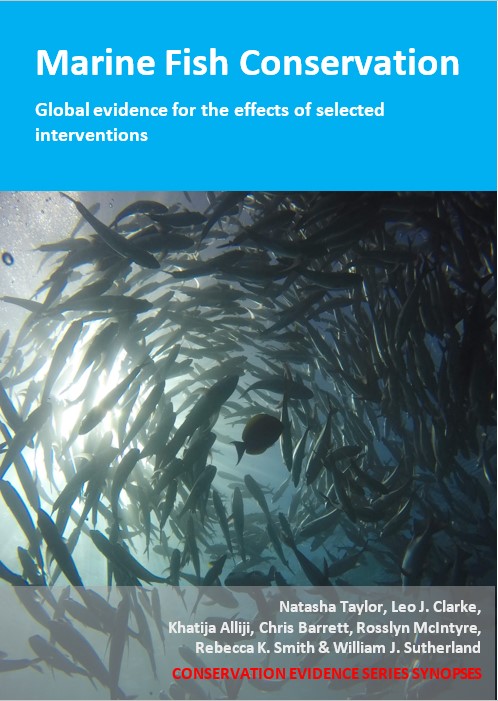Fit escape devices (panels/grids) to encircling nets
-
Overall effectiveness category Awaiting assessment
-
Number of studies: 3
View assessment score
Hide assessment score
How is the evidence assessed?
-
Effectiveness
not assessed -
Certainty
not assessed -
Harms
not assessed
Study locations
Supporting evidence from individual studies
A replicated, controlled study in 1998 of an area of sand and mud bottom in an estuary in the Tasman Sea, New South Wales, Australia (Gray et al. 2000) found that fish seine nets modified with transparent panels of netting improved the size-selectivity and increased the likelihood of escape of one of four commercially targeted species compared to conventional nets. The length at which fish had a 50% chance of escape was greater in modified nets than conventional nets for sand whiting Sillago ciliata (modified: 22.4 cm, conventional: 20.6 cm), and similar for three other commercial target species: sea mullet Mugil cephalus (modified:17.7 cm, conventional: 17.4 cm), flat-tail mullet Liza argentea (modified: 17.7 cm, conventional: 19.8 cm) and silver biddy Gerres subfasciatus (modified 12.2 cm, conventional: 12.3 cm). Percentage number (and weight) of fish escaping was higher in modified nets than conventional nets for flat-tail mullet (modified: 13%, conventional: 5%), but was not significantly different for sand whiting (modified: 50%, conventional: 48%), sea mullet (modified: 16%, conventional: 19%) and silver biddy (modified: 76%, conventional: 47%). In January–February 1998, a total of 15 shallow fish seine net deployments were made in Bellinger River estuary, New South Wales: 10 of a net modified with two transparent mesh panels (57 mm mesh size, 100 × 50 meshes long) in the wings leading to the codend, with and without a cover to sample the escaping fish; and five of a conventional seine net, with a codend cover (see paper for specifications of nets).
Study and other actions testedA replicated, controlled study in 1993–1995 at four coastal pelagic sites in the North Sea/Norwegian Sea, Norway (Misund & Beltestad 2000) found that using a rigid size-sorting escape grid in a purse seine net resulted in no difference in the survival of saithe Pollachius virens that had escaped through the grid, but survival of mackerel Scomber scombrus appeared reduced, compared to fish that did not pass through a grid. These results were not tested for statistical significance. Survival of saithe one month after capture was 97–100% for fish following use of an escape grid and 100% for fish that had not been through an escape grid. However, mackerel survival one month after capture was 18–56% for grid-escaped fish and 45–95% for fish that had not been through an escape grid. Three mackerel fishing trials were done by chartered purse seiners in August-September 1993–1995 at three coastal sites. Two saithe trials were done at one coastal site in April 1994 and by research vessel. Mackerel or saithe were captured by purse seine nets and towed inshore to large net pens. Fish that had passed through an escape grid were separated from fish that were caught in purse seine nets without grids. For mackerel, a 10 m2 metal grid with 42 mm bar spacing was fitted to the seine net and for saithe a 1 × 2 m2 glass fibre reinforced polyester grid with 30 mm bar spacing was fitted. As the nets were hauled in, fish escaping through the grids were collected in separate net pen. Across all trials, numbers of grid-escaped fish were 16,285 mackerel and 7,848 saithe. Fish that did not pass through an escape grid numbered 37,775 mackerel and 25,463 saithe. Survival was recorded weekly for a month.
Study and other actions testedA replicated study in 2003–2004 of a seabed area in the Atlantic Ocean off Portugal (Gonçalves et al. 2008) found that fitting a large-diamond mesh escape panel to a bottom purse seine net reduced the amount of unwanted or undersized fish catch compared to standard nets. For seven of seven fish species, including five important discarded species (see paper for species), the average weight of the species that escaped through the large-mesh panel were 6–231 kg/set and average escape rates were 7–92% (three species >85%, four species <59%). There was no difference in average size between escaped fish and fish discarded in commercial deployments without large-mesh panels for four of seven species (with: 12.3–42.5 cm, without: 11.9–42.3 cm) but size was significantly lower for three species (with: 12.6–18.7 cm, without: 13.4–19.0 cm). Sampling was done from April 2003 to July 2004, in a 36 km stretch of water within 10 km of the south coast of Portugal, at depths from 10–33 m. Eight experimental deployments were done from a small charter vessel using a standard bottom purse seine net of 18 mm mesh fitted with a 70 mm panel of diamond mesh, 4 × 6 m in the rear wing (see paper for specifications). Fish escaping from the large-mesh panel were sampled in an 18 mm mesh cover. Catches from 61 commercial purse seine deployments were sampled separately for proportions of fish kept and discarded. For all deployments, total catches or a sub-sample if large amounts were caught were sorted by species, weighed and lengths recorded.
Study and other actions tested
Where has this evidence come from?
List of journals searched by synopsis
All the journals searched for all synopses
This Action forms part of the Action Synopsis:
Marine Fish Conservation





)_2023.JPG)














